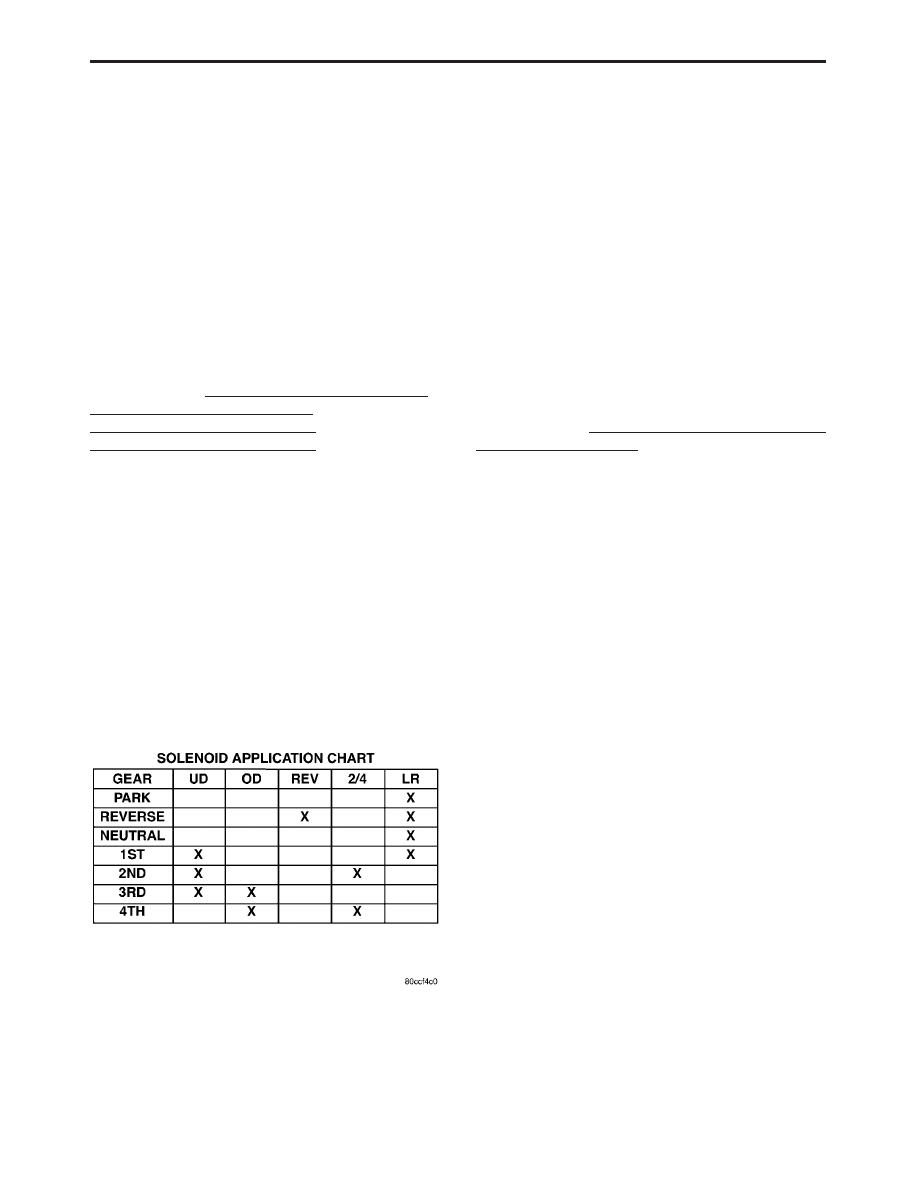Chrysler PT Cruiser. Manual - part 995

torque converter slip difference (difference be-
tween engine and turbine speed) is within 60 RPM.
Then the LR/TCC solenoid is fully energized
(FEMCC / 100% duty cycle). Torque converter slip
is monitored in FEMCC to ensure adequate clutch
capacity.
Transmission Effects: EMCC will still be avail-
able after code is set. MIL will illuminate after 5
minutes of accumulated slip in FEMCC. The trans-
mission will attempt normal operation (not in
Limp-in) even after the MIL is illuminated.
Possible causes:
> Worn pump bushing and/or failed torque con-
verter - both should be replaced during a rebuild
with code P0740(38) present
> Solenoid/Pressure Switch assembly.
Name of code: P0750(41) - LR Solenoid Circuit
P0755(42) - 2/4 Solenoid Circuit
P0760(43) - OD Solenoid Circuit
P0765(44) - UD Solenoid Circuit
When monitored: Ignition key is turned from off
position to run position and/or ignition key is
turned from crank position to run position, then
every 10 seconds thereafter, or when a gear ratio or
pressure switch error DTC is detected.
Set condition: All four solenoids are tested for
continuity continuously immediately upon start up
and during vehicle operation. For solenoids that
are currently energized, power is momentarily in-
terrupted, then reenergized. For solenoids that are
not currently energized, the solenoid is momen-
tarily energized, then de-energized. Under both
situations, if an inductive spike is not sensed by the
PCM during the continuity check, it is re-tested
twice. If it fails the test the third time, the appro-
priate code is set.
Theory of operation: Four solenoids are used to
control the friction elements (clutches). The conti-
nuity of the solenoids circuits are periodically
tested. Each solenoid is turned on or off depending
on its current state. An inductive spike should be
detected by the PCM during this test. If no spike is
detected, the circuit is tested again to verify the
failure. In addition to the periodic testing, the
solenoid circuits are tested if a gear ratio or pres-
sure switch error occurs. In this case, one failure
will result in the appropriate code being set.
Transmission Effects: The MIL will illuminate
and the transmission goes into neutral if code is set
above 35 Km/h (22 MPH), Limp-in mode when
vehicle speed is below 35 Km/h (22 MPH).
Possible causes:
> Open or shorted solenoid circuit(s) between PCM
and Transmission Solenoid/Pressure Switch as-
sembly
> Open ground circuit
> PCM connector problems.
> Solenoid/Pressure Switch connector problem.
> Solenoid/Pressure Switch assembly.
> PCM
Name of code: P1776(47) - Solenoid Switch Valve
Latched in LR Position
When monitored: Continuously when doing par-
tial or full EMCC (PEMCC or FEMCC)
Set condition: If the transmission senses the LR
pressure switch closing while performing PEMCC
or FEMCC. This code will be set after two unsuc-
cessful attempts to perform PEMCC or FEMCC.
Theory of operation: The solenoid switch valve
(SSV) controls the direction of the transmission
fluid when the LR/TCC solenoid is energized. SSV
will be in the downshifted position in 1st gear, thus
directing the fluid to the LR clutch circuits. In 2nd,
3rd, and 4th, the SSV will be in the upshifted
position and directs the fluid into the torque con-
verter clutch (TCC).
When doing PEMCC or FEMCC, the LR pres-
sure switch should indicate no pressure if the SSV
is in the TCC position. If the LR pressure switch
indicates pressure while in PEMCC or FEMCC,
EMCC operation is aborted and inhibited to avoid
inadvertent application of the LR clutch. Partial
EMCC will be attempted if the LR pressure switch
does not indicate pressure. A second detection of
LR pressure results in setting the code.
Transmission Effects: At speeds above 72 Km/h
(45 MPH), EMCC is inhibited. Once speed falls
below 72 Km/h (45 MPH), the transmission will go
into Limp-in mode and the MIL will illuminate
after 5 minutes of substituted operation.
Possible causes:
> Valve body - Solenoid valve stuck in LR position
> Intermittent short to ground or open circuit in
LR Pressure Switch Sense circuit (with code 24
only)
> Solenoid/Pressure Switch (with code P0841(24)
only)
> PCM (with code P0841(24) only)
12
GENERAL INFORMATION